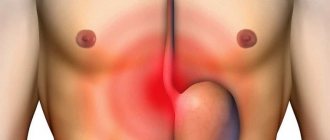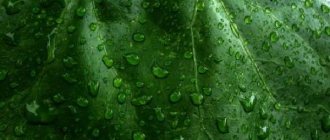Causes of green stool in adults
Among the main causes of green stool in adults, two can be distinguished: bile and food (food coloring, medications, dietary supplements). Let's take a closer look.
1) Bile secreted from the gallbladder is green in color, but as it passes through the intestines it gradually changes color and eventually turns brown. If it passes through the intestines quickly, the color remains original.
This also indicates a possible violation. Depending on the number of bile pigments, the color of the human stool itself is determined. In some cases, color directly depends on the food people eat.
2) Green feces in an adult can appear when consuming large amounts of food containing green coloring substances. These dyes are digested in the stomach, but the color of the stool becomes green. And the more dye there was in the food, the more intensely the stool will be colored.
The appearance of green stool can cause:
- consumption of foods containing iron;
- taking medications that contain inorganic iron compounds;
- eating red meats and fish;
- food and drinks containing dyes;
- green lettuce leaves, vegetables, and fruits, as well as juices from them;
- red bean varieties;
- sweets made from licorice syrup;
- sugar substitutes;
- iodine substances;
- dietary supplements containing iron;
- medicinal preparations made from seaweed;
- multivitamins.
Green poop is more common in vegetarians or vegetable eaters. Stool analysis reveals elevated bilirubin levels.
How to treat
The course of therapy will directly depend on the causative factor that provoked the appearance of green stool, and the treatment regimen should be selected on an individual basis. For example, if food products have affected the change in the color of stool, then the patient needs to reconsider his diet and, if necessary, limit or completely eliminate certain foods from it. These foods include red meat, cereals, cucumbers, and greens. It is recommended to avoid products containing food dyes. To cleanse the body of harmful substances, doctors prescribe Regidron, Smecta, Atoxil and other drugs.
If the cause of the change in stool color is infectious diseases, then self-medication is strictly not recommended. After determining the severity of the pathology, the doctor prescribes antibacterial and anti-inflammatory drugs. Often, a change in stool color is accompanied by severe diarrhea, which increases the likelihood of dehydration (along with feces, beneficial salts and minerals are washed out of the body, which significantly worsens the patient’s condition). To restore losses, experts recommend drinking a lot of liquid with added sugar and salt (for 1 liter of water - 1 teaspoon of salt and sugar).
Also, the appearance of green stool may be accompanied by bouts of vomiting, which indicates food poisoning in the body. In this case, it is necessary to rinse the stomach, freeing it of food. To rinse, the patient must drink a large amount of warm boiled water. It is necessary to drink until the urge to vomit appears (to speed up the cleansing of the stomach, you can use a weak solution of potassium permanganate).
Green feces in a child - causes and features
In children, after birth, the stool is dark olive, even in some cases black. This is considered the norm. Within 10 days, the stool is characterized by a greenish color of varying intensity. The color of a baby's stool is directly dependent on the characteristics of his diet.
During breastfeeding, green stool may appear, which is directly related to the diet of the breastfeeding mother, especially with excessive consumption of vegetables and carbohydrates.
Green stool in a bottle-fed baby indicates the use of iron-fortified formula. Gray-green stool appears when changing formula.
During the period of introducing complementary foods (fruits and vegetables), green stool may appear - this is also considered a normative option. When teething, sometimes the stool takes on a greenish tint.
But there are reasons, or rather diseases, that lead to a change in the color of feces. If they appear, you should immediately seek medical help:
- Intestinal infection (it can occur even in infants);
- Dysbacteriosis.
These diseases are manifested not only by a green tint to the stool, but also by vomiting, hyperthermia, and severe pain in the intestinal area. Feces become frequent and lead to dehydration of the child. If such symptoms occur, parents should immediately take their child to hospital for treatment.
Diseases associated with green stool (possible)
If green feces appear in an adult more than once, then the development of various diseases of the stomach and intestines is expected. The main diseases associated with green feces are:
- pathologies of the small intestine (not only a green color appears, but also a putrid unpleasant odor) - enteritis;
- dysbacteriosis (fermentation and rotting develop due to a deficiency of normal microbes necessary for the digestion process);
- long-term treatment with antibiotics;
- intestinal infection (for example, dysentery);
- bleeding from various parts of the intestine (with a stomach ulcer, with oncology). In this case, the stool is often black, but it can also be green;
- liver diseases (hepatitis, cirrhosis);
- blood diseases, especially those accompanied by hemolysis;
- hypolactasemia (indigestion and indigestion of milk sugar).
If there is pathology of the intestinal microflora, you need to start treating dysbacteriosis. Digestion of food with dysbacteriosis in the small intestine occurs incorrectly, resulting in the process of fermentation and rotting. And against this background, elements appear that saturate the feces with a green color.
All these diseases can lead to serious consequences. They are especially dangerous if they do not seek medical help in a timely manner.
Green feces often accompany intestinal infections (dysentery and other conditions). In this case, hyperthermia, a feeling of nausea, vomiting, pain in the abdomen, and a feeling of weakness appear.
To accurately diagnose a specific infectious pathology, a series of laboratory tests is required.
What to do?
Green diarrhea does not necessarily indicate a serious illness. It can be caused by carbonated drinks with artificial colors.
But, if for several days the color of feces does not return to normal, diarrhea continues, it is necessary to find the causes and identify the disease in a timely manner.
For diagnosis, laboratory testing of stool is performed. A bacterial culture must be done to find out which bacteria are causing the indigestion. A blood and urine test will show changes in the functioning of the body as a whole.
A coprogram is a comprehensive study that allows you to accurately determine deviations from the normal functioning of the gastrointestinal tract.
After analyzing the chemical and microscopic examination, the doctor can accurately determine the reasons for the appearance of green stool.
First of all, you need to exclude foods that could change the color of the stool. If digestion does not improve after this, measures must be taken.
Treatment depends on the reasons causing the change in stool color. A diagnosis cannot be made based on one symptom. Only after the test results are appropriate therapy prescribed.
Treatment boils down to the following techniques:
- For diarrhea , Smecta, Regidron
and other fixative drugs are prescribed; - For cramps and pain in the abdominal area, painkillers are used;
- Acute intestinal infections are treated with antibiotics;
- To restore the intestinal microflora, probiotics are used ( Linex, Bifiform,
etc.).
During treatment you must follow a diet. Smoked meats, fatty foods, foods high in coarse fiber, and alcohol should be excluded from the diet.
After a course of therapy, you should re-take the test.
Prevention of diseases, the symptoms of which are changes in the color of stool, comes down to simple rules of compliance with general rules of hygiene and sanitary standards for food preparation.
Dark green stool, what does it mean?
Dark green stool can appear when bleeding from various parts of the stomach or intestines. Such bleeding is regarded as complications of a peptic ulcer or as a sign of oncology.
The green color is acquired due to the incomplete oxidation of iron found in red blood cells. More than one dark green stool appears, but also signs of anemia, rapid pulse, low blood pressure, pallor, shortness of breath, and weakness.
In diseases of the liver and blood, large amounts of bilirubin appear. This is due to the intensive breakdown of red blood cells in the liver. Bilirubin gives stool a dark green to dark brown color.
Dark green stool can be regarded as a manifestation of mild dysentery. In severe cases, a large amount of water appears in it, reducing color saturation.
Yellow-green feces - what does it mean?
Improper absorption and digestion of carbohydrates from the fibers and connective tissue membrane of plant foods leads to changes in the small intestine and pancreas.
- The enzymes do not function as they should and yellow-green stool appears.
This color of stool is considered normal in breastfed babies. But if this color of stool appears in slightly older children, this indicates that the diet does not correspond to age.
You should review your diet, and you may need the help of a pediatrician and nutritionist.
Green stool in pregnant women
Now let’s look at why green stool occurs during pregnancy. Any mother wishes her child happiness and health. During pregnancy, her goal is to give birth to a healthy baby. For this, the body requires a large amount of nutrients and vitamins. Therefore, a pregnant woman’s diet contains a large amount of vitamins and minerals coming from plant foods and vitamin complexes. Excessive amounts of vitamins and minerals are not absorbed by the body and are excreted along with feces, which is what gives poop its green color. Please note that there should not be any other symptoms indicating the presence of pathology.
Is green stool with mucus dangerous?
Various factors can cause green stool with mucus:
- some types of intestinal infection;
- some types of hemorrhoids;
- tumor-like neoplasms in the intestine;
- congenital intestinal pathology or hereditary factor associated with enzymatic deficiency;
- congenital intolerance to milk sugar and gluten protein components;
- for hernias that cause food stagnation;
- manifestation of a gene mutation.
During the inflammatory process in the gastrointestinal tract, a large number of leukocytes die, which give the stool a green color. In addition, this is accompanied by severe pain in the abdominal area, diarrhea, and green mucus appears in the stool with purulent inclusions.
A coprogram helps confirm the inflammatory diagnosis - a large number of leukocyte cells are detected.
Drug treatment for green stools
Treatment of green diarrhea in adults directly depends on the causes that caused it:
- If diarrhea recurs frequently and is accompanied by loss of strength and fever, this indicates an intestinal infection. Doctors prescribe the intestinal antiseptic Enterofuril, the combined antimicrobial drug Dependal, sorbents, and the probiotic Lactobacterin.
- Diarrhea caused by taking medications requires discontinuation of the drug and restoration of the intestinal microflora with the help of Bifidumbacterin, Linex, Enterol and a special diet.
- In the case of green diarrhea associated with pancreatic dysfunction, the doctor prescribes enzymes: Pancreatin, Panzinorm forte.
- Diarrhea in an artificial baby is eliminated after changing the nutritional formula.
The antidiarrheal drug Imodium is prescribed only in cases of diarrhea of neurogenic origin. Antibiotics are used by a doctor after laboratory confirmation of the presence of bacteria.
It is possible that diarrhea is caused by lactase deficiency. You can get rid of it by eliminating milk from your diet. If you have an intolerance to grains (celiac disease), diarrhea disappears after removing gluten-containing foods from the menu.









